Search isn’t slowing down, but your team can’t afford to slow. For mid-market and growth-stage B2B SaaS companies, the gap isn’t ideas, it’s turning those ideas into publishable, trustworthy pages on a steady rhythm.
💡 That’s where AI SEO tools used inside a simple agile workflow make the difference: less time on busywork, more time on point-of-view, proof, and conversion.
This guide is a practical, non-technical playbook. We’ll show you exactly where AI fits (topic discovery, clustering, brief creation, draft scaffolds, on-page checks, reporting) and where humans must lead (voice, accuracy, EEAT, examples).
You’ll get a copy-ready sprint template, clear ownership, and lightweight metrics so content ships without drama and supports the numbers your board cares about: Demo rate, Trial→Paid, ACV, and CAC. For tool selection shortcuts, scan this best site audit tools round-up and this comparison of alternatives to Frase for SEO to kickstart briefs and clustering.
What you’ll walk away with:
- A step-by-step workflow from idea → brief → draft → publish → iterate, mapped to two-week sprints.
- Five essential tools (by job-to-be-done) and how to plug them into your board.
If you want content that compounds instead of clogs your backlog, start here.
Table of Contents
What People Mean by “AI SEO Tools”
AI SEO tools are assistants that help with research, writing support, on-page improvements, and reporting. They are not magic buttons; they speed up the routine parts so humans can add real expertise and voice.
What they do:
- Turn raw keyword ideas into organized topic groups (see our SaaS keyword research workflow).
- Suggest outlines, FAQs, internal links, and missing concepts (review AI content optimization tools for SaaS for what belongs in your stack).
- Flag readability gaps, basic schema opportunities, and broken links.
- Summarize performance so you know what to fix next (compare best SEO rank tracking tools to choose reporting that fits your sprint).
What they don’t do: Replace your point of view, industry examples, or editing standards. Humans still own the message, accuracy, and trust signals (quotes, examples, and references), which your SOP requires—see how to prove author expertise on SaaS blogs for credibility guardrails.
Where they fit: research → content → optimization → reporting (you’ll see this flow throughout the post).
Why Pair AI with Agile?
Agile means small tasks, short sprints, and steady wins. AI fills your sprint board with prepped tickets (topics, briefs, draft scaffolds, on-page suggestions), cutting idle time between roles.
AI SEO Tools: Comparison & How They Fit Your Agile Workflow
| Tool | Primary Use | Key Strengths | Watch-outs |
|---|---|---|---|
| Keyword Insights | Topic research & clustering; brief kickoff | Fast clustering from SERP overlap; one-click brief drafts | Over-tight clusters can fragment topics—human review needed |
| Surfer Content Editor | Outline guidance; term/heading coverage | Clear outline/FAQ suggestions; live optimization as you write | Don’t chase a numeric score over reader intent |
| Clearscope Optimize | Entity-aware edits; readability guardrails | Simple UI; readability targets; quick coverage gaps | Over-relying on suggestions can flatten voice |
| MarketMuse | AI briefs; depth & gap analysis | Strong brief scaffolds; good for SME-backed content | Generative output must be fact-checked |
| Screaming Frog SEO Spider | Internal linking & pre-publish QA | Precise crawls; exportable tasks (links, 4xx, duplicates) | Easy to over-scope audits—prioritize quick wins |
1) Keyword Insights — fast topic clustering & brief handoff
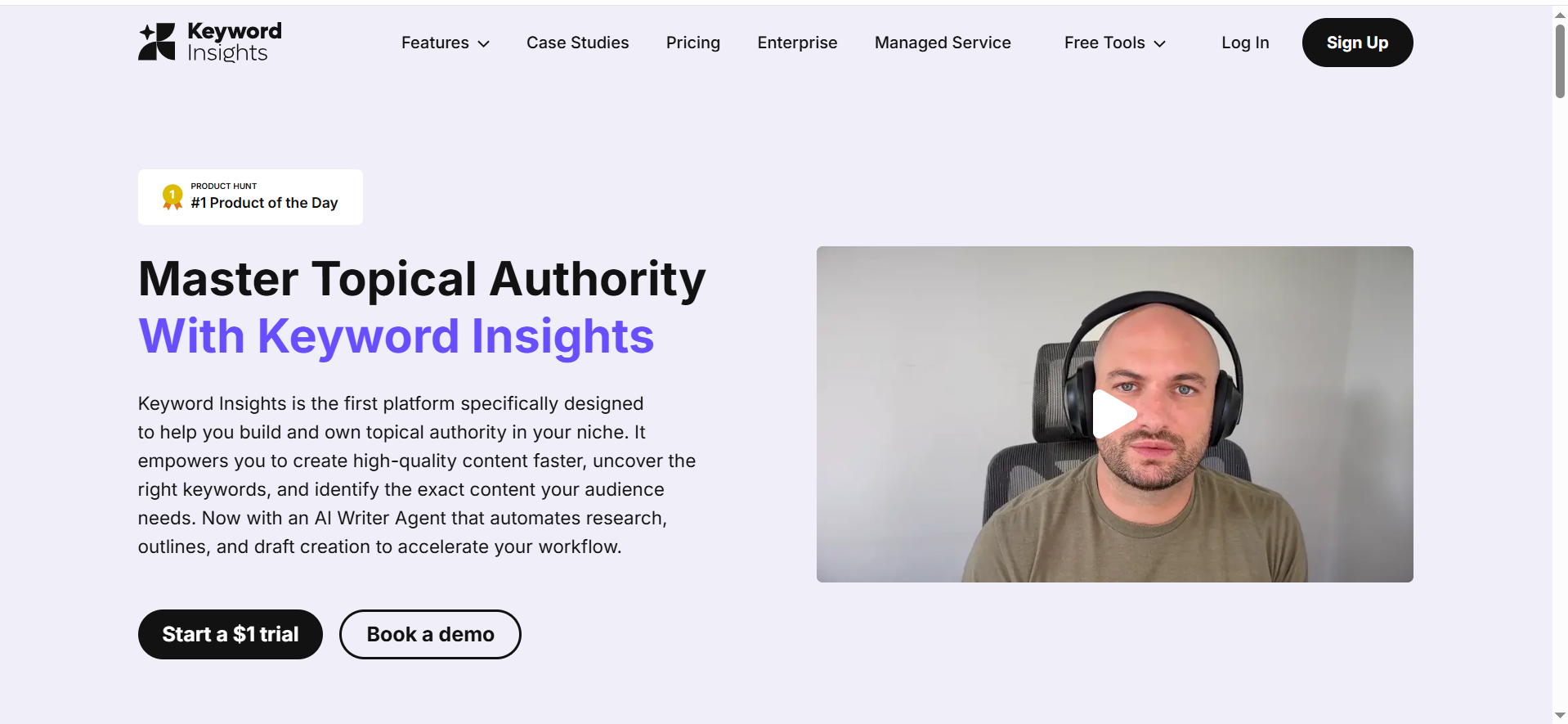
An AI-assisted platform that groups huge keyword lists into intent-based clusters using live SERP overlap and lets you send clusters straight to brief creation.
Why it matters for agile: It gives you “sprint-ready” tickets on Day 1: each cluster becomes a backlog item with a parent keyword, supporting queries, and search intent—so writers aren’t guessing.
Best use in your playbook:
- Research: Upload seed terms → get clusters → label intent (problem/solution/comparison/implementation).
- Content planning: One-click brief draft per cluster, then your editor adds POV, examples, and internal link targets.
- Setup & tips: Start with moderate SERP-overlap settings (don’t over-tighten). Export the CSV and attach it to each Jira/Notion card as your DoR/DoD artifact.
- Sprint checklist: “Cluster attached • Intent labeled • Brief auto-generated • Editor notes added.”
Pitfalls: Over-strict clustering can fragment topics; do a quick human pass before committing sprints.
Where it shines: New topic areas, “Topic Authority” programs, and any quarter where you need more briefs in less time.
2) Surfer Content Editor — outline guidance & term/heading coverage
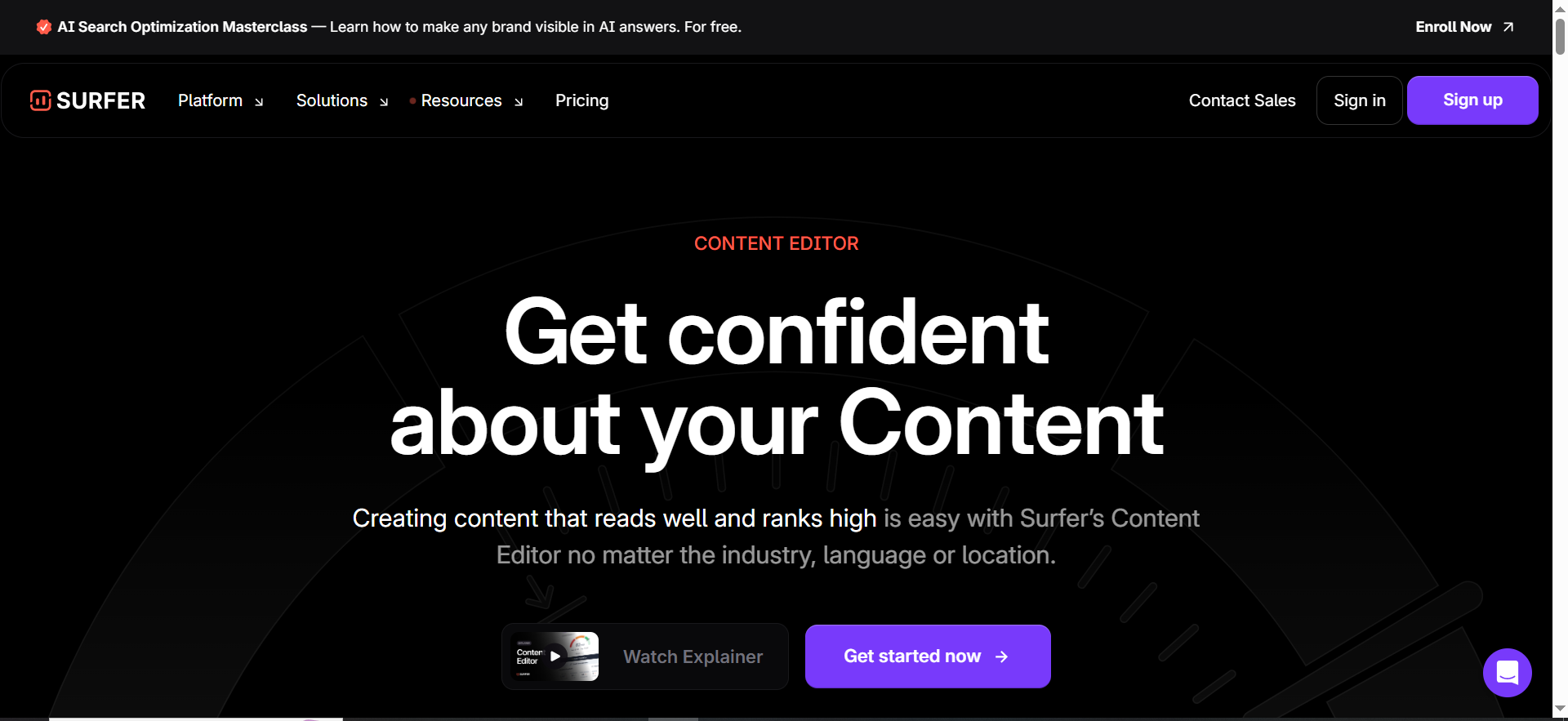
A writing workspace that suggests headings, questions, and important terms to cover; you can import existing drafts, build outlines, and optimize as you write.
Why it matters for agile: Speeds the 70–80% first draft phase so editors can spend time on voice, examples, and fact-checks—not structure.
Best use in your playbook:
- Drafting: Generate a section scaffold and FAQs for the writer.
- On-page: Close “entity gaps” before publishing and align multiple authors to one topic model.
- Setup & tips: Treat the score as a guardrail, not a target. If a suggested term doesn’t serve the reader's intent, skip it.
- Sprint checklist: “H2/H3 answer real queries • FAQs covered • Meta ideas noted.”
Pitfalls: Over-optimizing to a number. Keep intros outcome-oriented (SQLs/trials/ARR), then write naturally.
Where it shines: Multi-author teams that need consistency and faster time-to-draft.
3) Clearscope Optimize — entity-aware edits & readable drafts
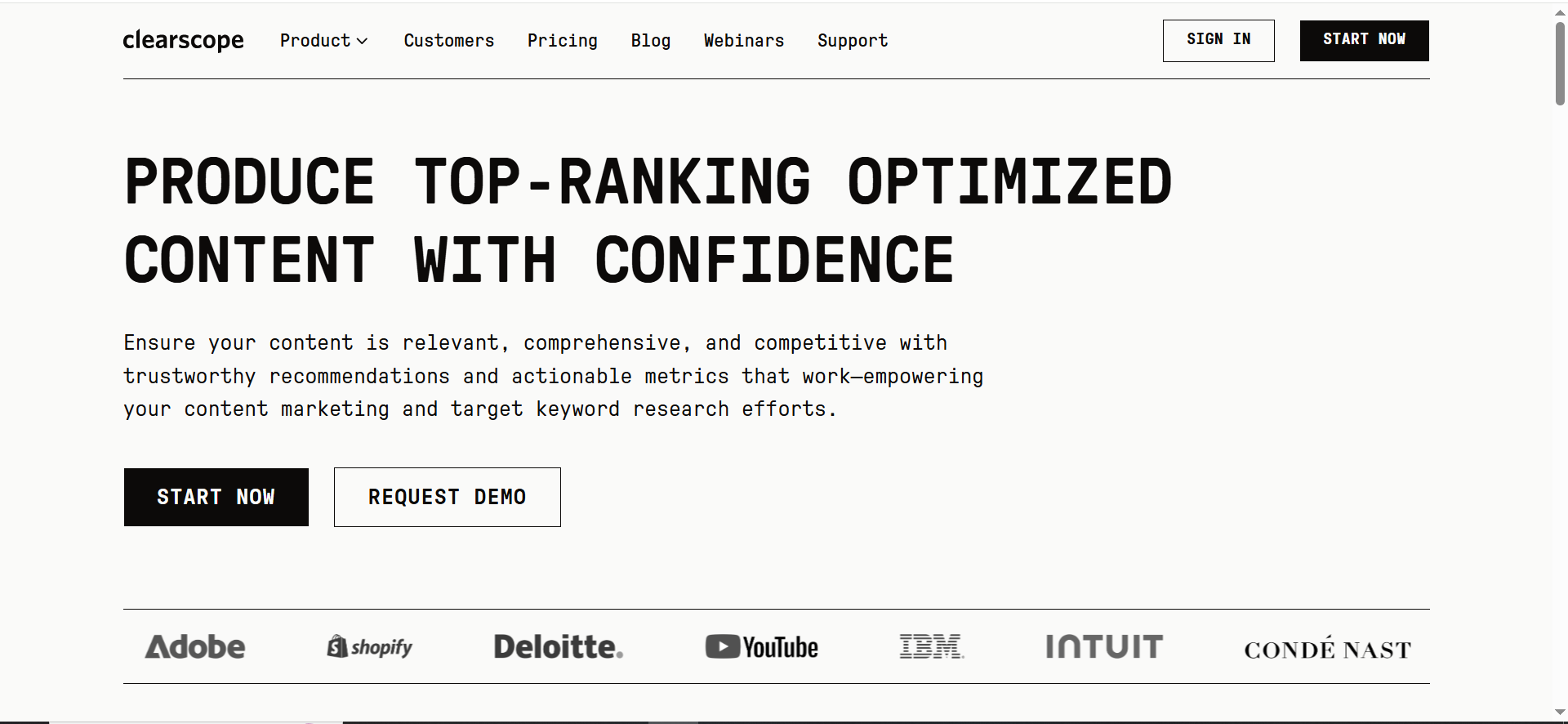
An AI-powered content optimization editor with real-time recommendations, readability guidance (e.g., Flesch-Kincaid), and simple scoring that non-SEOs can follow.
Why it matters for agile: Writers and PMMs can self-serve basic optimization while editors focus on EEAT. Great for keeping voice + depth + clarity without slowing sprints.
Best use in your playbook:
- Drafting: Tighten wording, ensure the right concepts are present, and keep reading level on target.
- On-page): Final “does this answer the query completely?” pass before publishing.
- Setup & tips: Save a few house profiles for reading level by persona (operator vs. exec) and reuse across clusters.
- Sprint checklist: “Readability within range • Missing concepts added • Internal links planned.”
Pitfalls: Don’t chase every suggestion, prioritize clarity and intent.
Where it shines: Teams that want writer-friendly guardrails and reliable readability/coverage checks.
4) MarketMuse — AI briefs & depth scoring for complex topics
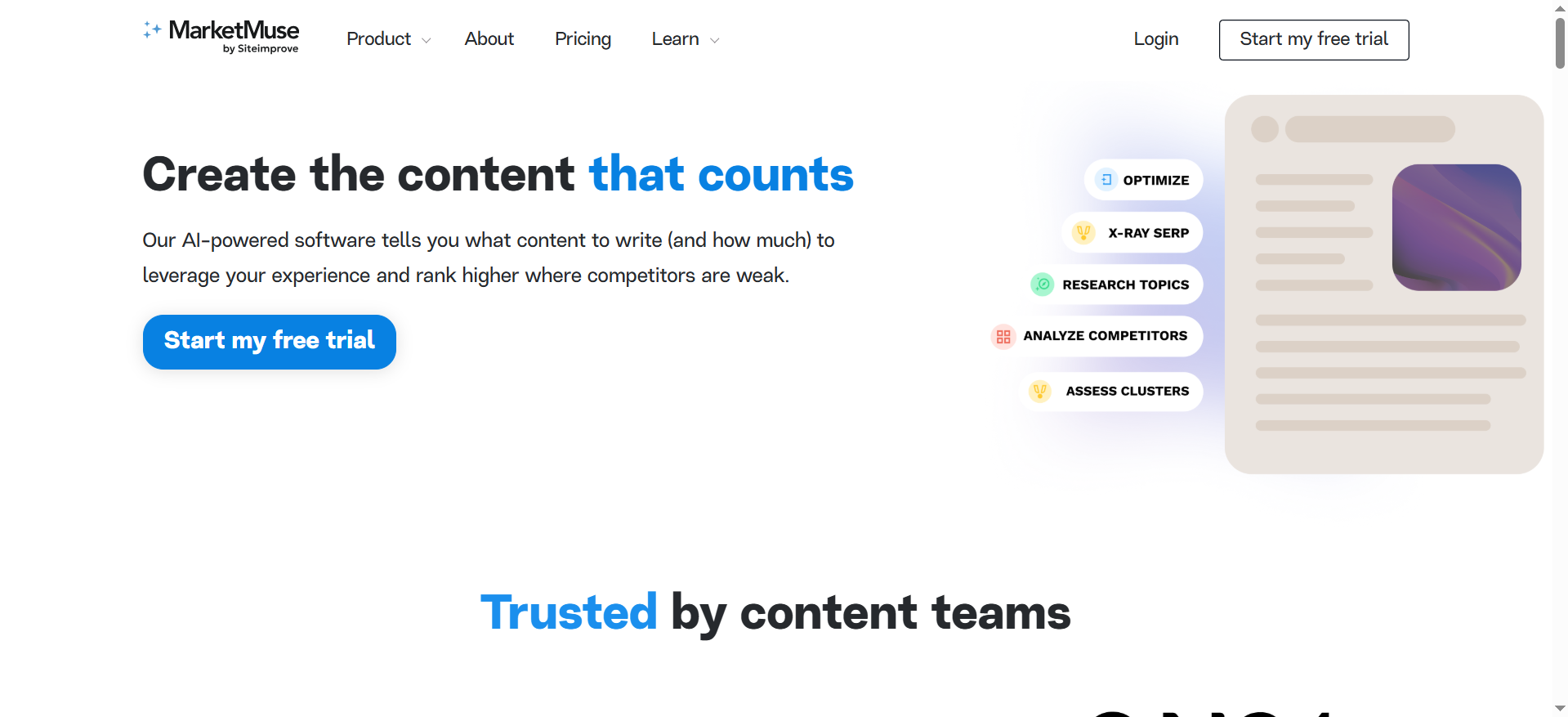
An AI content planning/optimization suite that generates briefs, surfaces coverage gaps, and promotes topical depth with a “human-in-the-loop” approach.
Why it matters for agile: When your niche is technical, MarketMuse helps ensure comprehensiveness so posts pass editor review quickly (fewer rewrite loops).
Best use in your playbook:
- Briefs: Use AI brief drafts to specify subtopics, questions, and evidence to collect—then add your POV and sources.
- Drafting/On-page: Expand thin sections and check depth against competitors; build EEAT with expert quotes.
- Setup & tips: Pair with your expert review step, flag where a SME quote or screenshot is needed.
- Sprint checklist: “Brief accepted • Coverage gaps closed • Two expert citations added.”
Pitfalls: Generative suggestions still require fact-checking. Keep editors in the loop.
Where it shines: Implementation guides, comparison pages, and long-form content where depth = trust.
5) Screaming Frog SEO Spider — fast internal-link & pre-publish QA
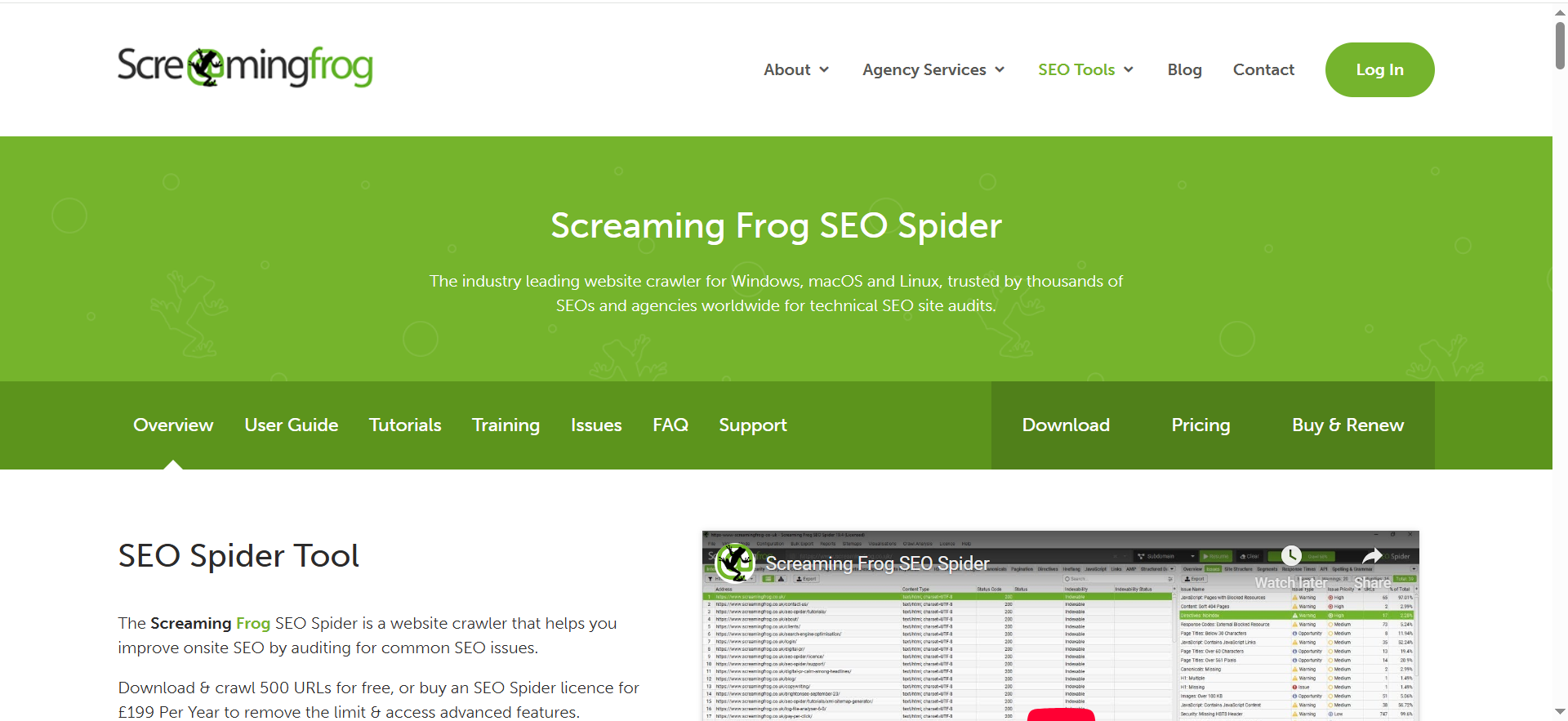
A pro-grade site crawler you can use for internal-linking audits, broken links, duplicate titles, redirect chains, and other pre-publish checks.
Why it matters for agile: Turns “technical debt” into bite-sized sprint tasks e.g., add 3–5 internal links to every new post, fix 404s, and surface orphan pages as quick wins.
Best use in your playbook:
- On-page/QA: Run a crawl after each publish wave; export a list of linking opportunities and attach to tickets for the next sprint.
- Setup & tips: Keep a saved crawl profile for your site; filter for “orphan/near-orphan” content and “Pages with weak inlinks.”
- Sprint checklist: “3–5 links added per new URL • 4xx/5xx cleared • Duplicate titles fixed.”
Pitfalls: Easy to over-scope audits. Stick to quick wins that move discovery/crawl efficiency first.
Where it shines: Mid-market sites where internal linking and basic hygiene lift visibility across a whole cluster.
End-to-End Workflow: Turn Ideas into Briefs, Drafts, and Live Pages—Fast
Think of this as your “from idea to impact” loop. Each stage produces a tangible output your team can drop into the sprint board, so nothing lingers in limbo.
1. Research (Find Topics People Actually Want)
Start by sweeping real customer signals: product use cases, sales and success call notes, support tickets, and search data.
Feed those into your research tool to reveal clusters, groups of closely related queries that deserve a page or small set of pages (tool fit matters - see Frase alternatives to compare options for clustering and outline kickoffs).
Give each cluster an intent label (problem, comparison, solution, or implementation) and a funnel stage (TOFU/MOFU/BOFU), then rank by business impact and effort.
The final step is operational: create sprint tickets with a clear definition of done—working title, primary and secondary terms, intent, and the one metric that will tell you the page worked. Your output is a prioritized topic list with search intent and owners, ready to brief.
👉 Micro-check: 1–2 primary keywords + 5–10 secondaries • Intent labeled (TOFU/MOFU/BOFU) • Draft H1/H2s tied to a value prop • Ticket has DoD, owner, and due date.
2. Content Planning (Turn Ideas into Tickets)
Each approved topic becomes a one-page brief. Keep it simple and useful: a working title, the target persona, the core angle, proposed subheads, and the FAQs people actually type.
Add 3–5 internal link targets so the eventual draft doesn’t ship as an orphan. List the “evidence to source” (quotes from SMEs, data points, screenshots) to protect quality later.
Assign the brief to a writer with an editor checkpoint; nothing moves to drafting until the editor signs off. Your output here is a stack of ready-to-write briefs sitting neatly in the sprint board.
👉 Micro-check: Angle and promise are explicit in the intro • 3–5 FAQs written as queries • Internal link targets identified • Evidence list (quotes, stats, examples) is complete.
3. Drafting (Human + AI Co-writing)
Use AI to accelerate the boring part “structure and a solid first pass” then let your writer bring the human value: voice, precision, examples, and judgment. Start with a generated outline (intro, H2/H3s, FAQs) and a lightweight first draft.
Layer in product-aligned stories, objections you hear in sales calls, and concrete claims that can be cited. Before optimization, run an editor pass for clarity and EEAT: are quotes present, are sources reputable, is there an anonymized example, and does the copy reflect how your buyers speak?
Close with originality and readability checks. The output is a 70–80%-complete draft that already answers the query and sounds like your brand (for inspiration on outcomes from AI-assisted content, review our AI SEO BOFU case study).
👉 Micro-check: Intro ties to SQLs/trials/ARR/CAC outcomes • Two expert quotes or POVs included • One anonymized mini-example added • At least two third-party references cited.
4. On-Page Optimization (Make It Easy to Rank)
Now strengthen the page’s discoverability. Scan headings and body for missing entities or subtopics a searcher would expect; add them if they improve clarity.
Place 3–5 internal links to related posts and product pages so the new URL is woven into your site’s graph. Where it fits, add simple structured data (FAQ or HowTo) to improve snippet potential.
Tighten your meta title (≤60 chars) and description (≤155) to match the promise in your intro. The output is an optimized draft that can ship with confidence, if you’re short on bandwidth, our SaaS content audit & fix sprint packages these on-page wins into a fast implementation cycle.
👉 Micro-check: Entity gaps closed • 3–5 internal links added • FAQ/HowTo schema considered • Meta title/description polished to spec.
5. Publish & Distribute
Treat publishing as the moment quality meets conversion. Do a quick pre-flight: compressed images with alt text, clean slug, live internal links, accurate meta.
Layer three CTAs that match reader intent: an inline value CTA (download, checklist), a mid-post product CTA (see it in action), and an end CTA to book a demo or sprint map.
Push the post via social and email, and share a one-pager with sales so they can use it in conversations. Add UTM parameters if you want clearer attribution. Your output is a live page that serves readers and your funnel.
👉 Micro-check: Inline, mid-post, and end CTAs present • UTMs added • Social/email distribution done • Sales one-pager shared.
6. Monitor & Improve
Don’t wait months to learn, pulse weekly. Look at impressions/clicks (are we being discovered?), engagement (are people staying?), and conversions (are CTAs earning their keep?).
Pick two quick fixes for the next sprint, perhaps an added FAQ, stronger internal links from older pages, or a clarified subhead. Schedule a larger refresh at the six-to-nine-month mark for winners and underperformers alike.
The output is a steady stream of small, compounding improvements rather than a costly overhaul later. If you need a steady partner on goals and cadence, our SaaS SEO agency team can run the loop with you.
👉 Micro-check: Weekly note on “what moved” • Two backlog items created (one refresh, one linking push) • Refresh date logged.
Quality & Safety (Keep It Trustworthy): Fact-Checks, Voice Control, and Risk Guards
Your content has one job: be useful and believable. Treat quality like a gate, not a vibe.
▶️ Start by verifying every claim that could affect a customer’s decision. Keep a simple “claims ledger” in the doc: the sentence, the source, the date checked. If you can’t verify it quickly with a reputable source or your own data, cut it or rewrite it. Screenshots and small product snippets beat abstract promises, use them (for outcome examples, see our AI SEO BOFU case study)
▶️ Lock in brand voice so multiple authors sound like one team. For this post type, keep it consultative, SaaS-savvy, growth-focused: short sentences, no fluff, explain “why it matters” in one line before you dive into “how.” Maintain a one-page voice guide (tone, banned buzzwords, preferred terms) and pin it to the sprint board.
▶️ Guard against thin or duplicate content by giving each URL a single clear angle and a written Definition of Done (DoD) before drafting: the question we answer, the POV we bring, and the next action we want. If another page already answers the same question, merge or differentiate on purpose (audience, scenario, or depth). When bandwidth is tight, a focused SaaS content audit & fix sprint quickly surfaces duplicates, thin sections, and missing trust signals.
▶️ Finally, ship nothing without an editorial compliance pass. Keep a lightweight 20-point checklist (fact-check complete, citations present, originality check passes, screenshots alt-texted, CTAs match funnel stage, schema considered, internal links added). Editors don’t “polish” what they enforce. If a box is red, it doesn’t publish. If you need a steady partner to run this gate, our SaaS SEO agency can own the final EEAT and internal-linking checks.
Micro-check (before publish): facts verified • examples/screenshots included • voice guide followed • unique angle & DoD met • editorial checklist passed.
Common Mistakes (and Easy Fixes): Quick Wins to Keep Sprints on Track
| Common mistakes | Why it hurts | Easy fix |
|---|---|---|
| Publishing too fast without human edit | Missed errors, weak EEAT signals, lower trust and conversions | Add a 10-minute editor pass to verify facts/citations, tighten voice, and confirm screenshots/alt text before publish |
| Targeting too many topics | Work-in-progress balloons, drafts stall, diluted impact | Cap scope at 5–10 pages per sprint and prioritize by intent × business value |
| No internal links | Orphan pages, poor crawl/discovery, weaker topical authority | Add 3–5 internal links per page to related posts and key product pages |
| Ignoring updates | Content goes stale, rankings decay, missed conversion lifts | Refresh winners every 6–9 months and repurpose strong sections into checklists or sales collateral |
Frequently Asked Questions
Yes, when it’s accurate, edited, and genuinely useful. Use AI for speed (outlines, first drafts, FAQs), then have a human add facts, sources, examples, and brand voice. Run a quick fact-check pass, add 1–2 expert quotes or data points, and make sure the piece actually answers the searcher’s question. If a claim can’t be verified, cut it. Thin, unedited AI text is what gets ignored.
No. Start lean: one tool each for research/clustering, briefs, draft assist, on-page optimization, and reporting. That’s enough to run sprints and grow output. As your throughput rises (more pages per sprint, bigger site), then consider upgrading. Simplicity beats a bloated stack—pick tools your writers and editors will actually use.
You’ll often see early signals in weeks: impressions rise, a few queries start ranking, engagement nudges up. Meaningful traffic and pipeline lift builds over multiple sprints. Keep shipping, add internal links to new pages, and plan a refresh at 6–9 months for winners (update stats, add FAQs, improve examples). That cadence compounds.
No. AI reduces busywork (structure, summaries, entity checks). Writers and editors bring expertise, stories, judgment, and trust the parts readers and rankings reward. Keep an editor as the final gate for EEAT (experience, expertise, authority, trust) and brand consistency. The best teams use AI to go faster, not to lower the bar.
Turn up the human layer. Spend more time on fact-checking, add subject-matter quotes, and include screenshots or short walkthroughs. If client data isn’t public, use anonymized examples (“SaaS in fintech, 120 seats”) and explain the setup so it’s still credible. Complex niches win with depth + clarity, not more keywords.
Conclusion: Ship More, Learn Faster, Win Bigger
For mid-market and growth-stage B2B SaaS, the real constraint isn’t ideas, it’s throughput with quality.
Pairing AI SEO tools with a light agile workflow turns topics → briefs → drafts → published pages on a reliable cadence, with layered CTAs and clear measurement. That’s how you move Demo rate, Trial→Paid, and ACV while keeping CAC in check.
Use AI where it compounds (research, clustering, briefs, draft scaffolds, QA) and keep humans where trust is earned (voice, examples, EEAT). Measure like operators “throughput, discovery, engagement, and business impact” and roll those insights into two small improvements every sprint (for proof of outcomes from AI-assisted content, see our AI SEO BOFU case study). You don’t need a pricey stack: one solid tool per stage, a 2-week rhythm, and a 10-minute retro will show signal in weeks.
Refresh winners at 6–9 months—our B2B SaaS content audit checklist makes refreshes faster and repeatable—and keep internal links flowing to compound gains.
Next steps (drop into your board):
- Choose one cluster → create 5–10 briefs → assign owners/dates.
- Draft with AI assist → editor EEAT pass → on-page checks → publish with 3 CTAs.
- Retro: log what moved → add one refresh + one internal-link push to next sprint. If you want a partner to run the cadence end-to-end, our SaaS SEO agency can operate the loop while your team focuses on product and pipeline.
▶️ Want this live on your site? Book a 30-minute call with The Rank Masters and turn this framework into pages and pipeline.




